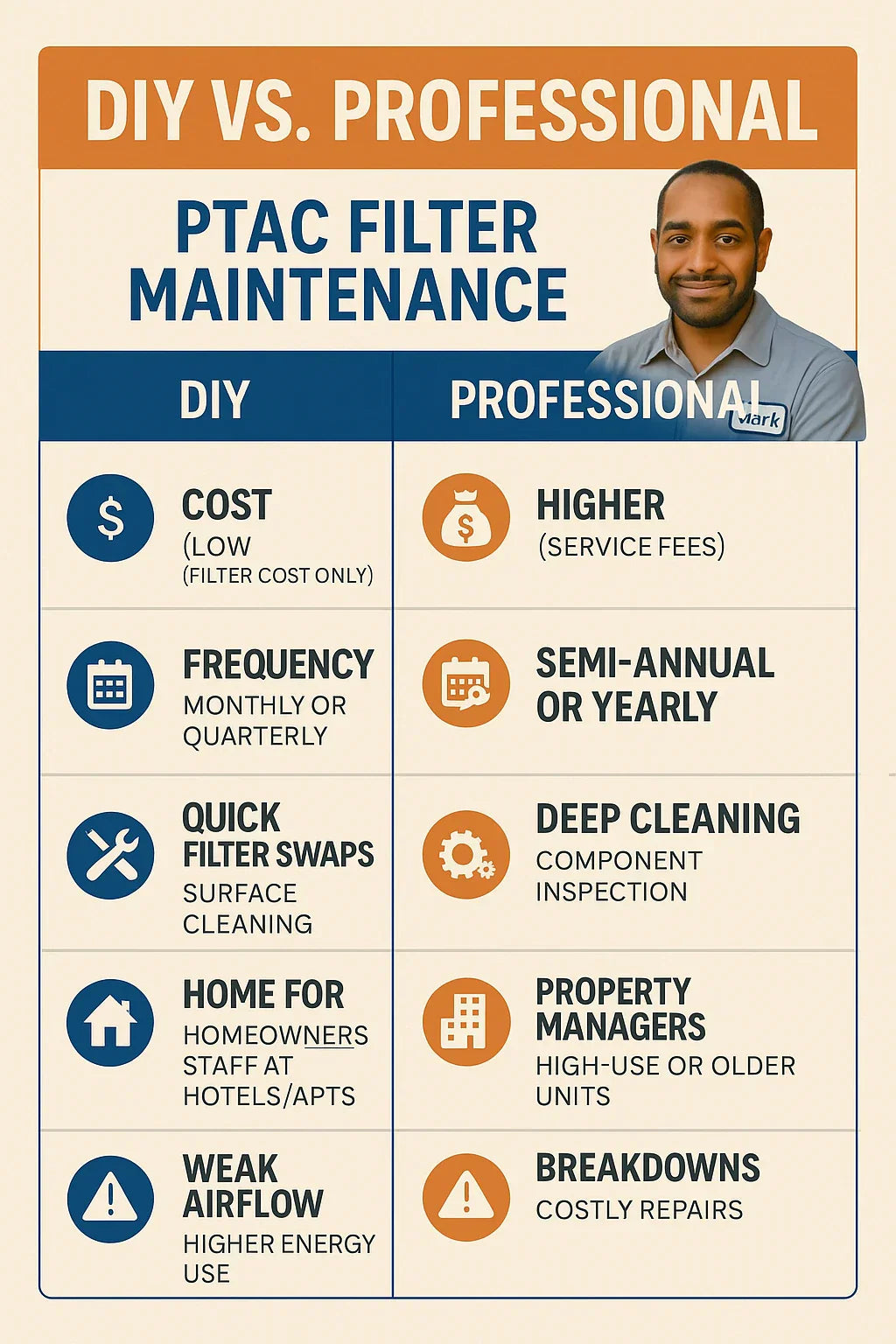📖 Introduction: The Question I Hear All the Time
When I visit hotels or apartment complexes, property managers often ask me:
👉 “Should we handle PTAC filter changes ourselves, or call in a pro?”
It’s a fair question. On the one hand, filters are easy — anyone can slide one out and replace it. On the other hand, ignoring small details can lead to big problems later.
Hotpoint PTAC Replacement Filters (Pair of 2)
After 15+ years installing and servicing PTACs, here’s my honest take: DIY and professional maintenance both matter. Filters are simple enough for you to handle day-to-day, but pros are essential for long-term system health.
This guide breaks down the differences, the pros and cons, and my field-tested recommendations for homeowners, hotels, and property managers.
🧰 DIY Filter Maintenance: The Basics
Filters are the first line of defense for your PTAC. Luckily, you don’t need to be an HVAC pro to keep them in shape.
What You Can Do Yourself
-
🗓️ Monthly Filter Checks
Pop the grille, slide out the filter, and inspect it against the light. If you can’t see through it, replace it. -
🔄 Regular Replacements
Replace filters every 30–90 days, depending on use and environment. Hotels or pet-friendly units? Stick closer to 30 days. -
🧽 Surface Cleaning
Vacuum the intake grille and wipe down dust around the filter slot. -
📋 Track Dates
Log when each filter was replaced to prevent units from slipping through the cracks. -
🏨 Train Staff
In hotels, housekeeping can be trained to check filters during regular room service.
📌 Reference: ENERGY STAR recommends checking filters monthly and replacing them at least every 3 months .
💡 Mark’s Pro Tip: Don’t just wait until the filter “looks dirty.” It’s already losing efficiency long before it looks clogged.
🛠️ Professional Filter Maintenance: Beyond the Basics
While DIY covers the day-to-day, professional maintenance digs deeper.
What Pros Handle
-
🌀 Deep Coil Cleaning
Dust bypassing a filter clogs coils, reducing heat transfer. Pros use specialized cleaners and tools to restore performance. -
💧 Drain Line Inspection
A dirty filter can lead to ice and excess condensation. Pros ensure drains are clear to prevent leaks and mold. -
🔍 Filter Slot & Seal Check
A misaligned filter lets air bypass. A pro makes sure the filter area seals tight. -
⚡ Component Check
Blower motors and compressors often strain from filter neglect. Pros spot early warning signs before breakdowns. -
🏢 Property-Wide Efficiency
For hotels or multi-unit buildings, pros can evaluate patterns and recommend replacement schedules tailored to your usage.
📌 Reference: AHRI (Air-Conditioning, Heating, and Refrigeration Institute) stresses that professional cleanings extend equipment life and efficiency .
💡 Mark’s Pro Tip: Even if staff handles swaps, schedule pro inspections 2–3 times a year for peace of mind.
⚖️ DIY vs. Pro: The Pros & Cons
| Aspect | DIY Filter Maintenance | Professional Maintenance |
|---|---|---|
| Cost 💵 | Low (cost of filters only, ~$20 per pair) | Higher ($200–$500 per visit depending on services) |
| Frequency 🗓️ | Monthly/Quarterly | Semi-annual or annual |
| What’s Covered 🔧 | Filter swaps, surface cleaning | Deep coil cleaning, drain checks, motor inspection |
| Best For 🏠 | Homeowners, staff at hotels/apts | Property managers, high-use or older units |
| Risk If Ignored ⚠️ | Weak airflow, odors, higher bills | Full system breakdown, costly repairs |
📌 Reference: The U.S. Department of Energy notes that clogged filters are the #1 cause of premature HVAC failure .
💡 Common Mistakes in DIY Filter Maintenance
Over the years, I’ve seen the same mistakes repeated:
-
❌ Using generic filters that don’t fit right — allowing dust bypass.
-
❌ Installing backwards — some filters are directional.
-
❌ Waiting until problems appear — by then, efficiency is already down.
-
❌ Skipping records — in hotels, units often get missed without logs.
💡 Mark’s Pro Tip: Always stick with OEM filters (like GE Hotpoint). They’re designed for airflow and fit, which prevents 90% of issues I see.
🏨 Case Study: DIY vs. Pro in Hotels
I worked with two hotels last year:
-
Hotel A: Housekeeping checked and replaced filters monthly, but no pro service for 2 years. Units started icing up, and energy bills climbed. We found coils caked in dust bypass.
-
Hotel B: Staff handled monthly checks and scheduled professional cleaning twice a year. Their PTACs ran strong, guests were happy, and bills stayed consistent.
👉 The lesson? DIY keeps units running daily, but professional service protects long-term performance.
📈 The Cost Impact of Ignoring Filters
Let’s compare:
-
OEM filter replacement: $20
-
Coil cleaning from dust bypass: $200–$400
-
Blower motor replacement: $300–$500
-
Compressor burnout: $800–$1200
-
Full PTAC replacement: $700–$1500
💡 Mark’s Pro Tip: Think of OEM filters as $20 insurance policies against $1000 disasters.
📝 Mark’s Final Recommendations
Here’s what I recommend after years in the field:
-
🏠 Homeowners: DIY is enough — just check filters monthly and always use OEM.
-
🏨 Hotels: Train staff for swaps, but schedule 2–3 professional services a year.
-
🏢 Property Managers: Keep a log system to track all units. Bulk order OEM filters for consistency.
👉 Bottom line: DIY keeps things moving, pros keep things lasting.
In the next topic we will know more about: Do PTAC Replacement Filters Improve Indoor Air Quality? How filters impact guest comfort, dust, allergens, and even noise from overworked fans.







